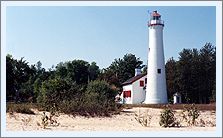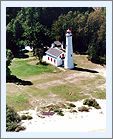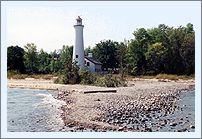|
Historical Information

Sturgeon Point sits approximately halfway between the northern point of
Saginaw Bay and Thunder Bay Island. While the Point lay somewhat off the
main north/south shipping lanes, the Lighthouse Board noted that
"vessels frequently, from various causes, get out of the direct
course, and a light-house at this point would enable them to take a new
departure and shorten the long stretch across the mouth of Saginaw
bay." A shallow reef lurking below the surface for a mile and a
half beyond the Point added to the dangers associated with passing close
by the Point, and estimating that a lighthouse could be erected here for
$15,000, the Lighthouse Board requested an appropriation of that amount
in its annual report for 1866. Congress responded quickly, granting an
appropriation for the requested amount on March 2, 1867.
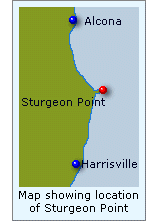 By July, an agreement had been reached
with local landowner John Sabin for the purchase 60.2 acres of land on
the Point, and title papers had been filed with the US District
Attorney. After plans and specifications for the station were drawn up
and approved on July 6 1868, arrangements were made to begin
construction on the opening of the 1869 navigation season. By July, an agreement had been reached
with local landowner John Sabin for the purchase 60.2 acres of land on
the Point, and title papers had been filed with the US District
Attorney. After plans and specifications for the station were drawn up
and approved on July 6 1868, arrangements were made to begin
construction on the opening of the 1869 navigation season.
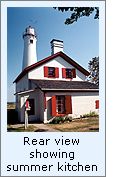 Work began with the excavation and
erection of the tower foundation. Consisting of cut limestone blocks,
the foundation stood sixteen feet in diameter; seven feet six inched in
height, with the upper three feet exposed above grade. Atop this
foundation, a team of masons erected the cream city brick tower.
Standing sixteen feet in diameter at its base with its massive walls
four feet six inches in thickness, the walls tapered gracefully to a
diameter of ten feet at their uppermost, at which point they had
narrowed to a thickness of eighteen inches. Supported by ten gracefully
curved corbels, a copper-clad gallery was installed and encircled by an
iron safety railing. Work began with the excavation and
erection of the tower foundation. Consisting of cut limestone blocks,
the foundation stood sixteen feet in diameter; seven feet six inched in
height, with the upper three feet exposed above grade. Atop this
foundation, a team of masons erected the cream city brick tower.
Standing sixteen feet in diameter at its base with its massive walls
four feet six inches in thickness, the walls tapered gracefully to a
diameter of ten feet at their uppermost, at which point they had
narrowed to a thickness of eighteen inches. Supported by ten gracefully
curved corbels, a copper-clad gallery was installed and encircled by an
iron safety railing.
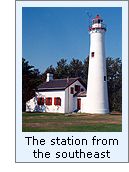 Plans for the two-story dwelling called
for a kitchen, pantry and storeroom on the first floor, and a sitting
room and three bedrooms on the second floor. The dwelling was attached
to the tower by an eleven-foot long covered passageway to provide the
Keeper access to the tower without having to leave the warmth of the
building during inclement weather. A cast iron door at the tower end of
the passageway was installed to stem the spread of a possible fire
between the two structures. Plans for the two-story dwelling called
for a kitchen, pantry and storeroom on the first floor, and a sitting
room and three bedrooms on the second floor. The dwelling was attached
to the tower by an eleven-foot long covered passageway to provide the
Keeper access to the tower without having to leave the warmth of the
building during inclement weather. A cast iron door at the tower end of
the passageway was installed to stem the spread of a possible fire
between the two structures.
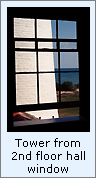 By the end of July, the exterior of the
dwelling was complete, and the tower completed to the point that it was
ready to receive the lantern. The decagonal cast iron lantern was
erected at the center of the gallery, and covered with a tapered iron
roof with ventilator ball, standing seventy feet nine inches above grade
level. A lightning rod atop the ventilator ball was attached to a copper
cable, which lead down the outside of the brickwork to a ground stake
driven alongside the foundation. A spiral cast iron staircase with three
landings wound its way within the tower to a hatchway through the
keepers could gain access to the lantern. By the end of July, the exterior of the
dwelling was complete, and the tower completed to the point that it was
ready to receive the lantern. The decagonal cast iron lantern was
erected at the center of the gallery, and covered with a tapered iron
roof with ventilator ball, standing seventy feet nine inches above grade
level. A lightning rod atop the ventilator ball was attached to a copper
cable, which lead down the outside of the brickwork to a ground stake
driven alongside the foundation. A spiral cast iron staircase with three
landings wound its way within the tower to a hatchway through the
keepers could gain access to the lantern.
The station's fixed white Third and a
Half Order lens, had previously been installed in the lighthouse at
Oswego, New York until a characteristic change at that station rendered
the lens obsolete. The lens had been carefully crated and shipped to
Detroit, where it had been in storage for some time. The District
Lampist arrived at Sturgeon Point, and after supervising the movement of
the lens segments into the lantern, assembled the glass gem on a cast
iron pedestal designed to place the "Sweet spot" of the lens
at the required elevation in the lantern.
 Perley Silverthorn, a
fisherman and owner of property close to the new station who had been
living in the area since 1854 was appointed as the station's first
Keeper. However, after Silverthorn, his wife Caroline and their four
children failed to report for duty at the station until November 19, it
was deemed too late in the season to exhibit the Light. Thus, on January
2, 1870 an official Notice To Mariners was posted announcing that the
new Light would be lighted on the opening of navigation that spring. Perley Silverthorn, a
fisherman and owner of property close to the new station who had been
living in the area since 1854 was appointed as the station's first
Keeper. However, after Silverthorn, his wife Caroline and their four
children failed to report for duty at the station until November 19, it
was deemed too late in the season to exhibit the Light. Thus, on January
2, 1870 an official Notice To Mariners was posted announcing that the
new Light would be lighted on the opening of navigation that spring.
For reasons that we have as yet been
unable to determine, Silverthorn was removed from his position as Keeper
on August 19, 1873, and Noah T Farr selected as Acting Keeper of the
station, appearing on payroll listings for the station for the first
time on October 14. While Farr was promoted to full Keeper status in
September 1875, his stay at Sturgeon Point was not long-lived, as he
resigned from Lighthouse service on May 18 1876, with John Pasque
appointed to replace him.
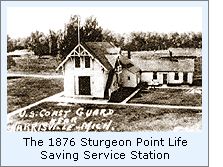 Construction began on a Life-Saving
station at the south of the Lighthouse reservation soon after Pasque's
arrival. On completion of the new station, Perley Silverthorn again made
an appearance at Sturgeon Point, after managing to arrange his
appointment as Keeper of the new Life Saving station. While Silverthorne's
annual pay as keeper of the Life Saving Station was half of the $400 he
earned as a Light keeper, he likely found the new position a great deal
more challenging, as he was now responsible for seven cantankerous
surfmen and living the Service's motto of "You have to go out, but
you don't have to come back." John Pasque accepted a transfer to
the higher paying position of Acting Keeper at Stannard Rock in Lake
Superior on June 6, 1882, and Louis Cardy Sr. was transferred-in from
Skillagallee, where he had hired into lighthouse service as Second
Assistant just two months earlier. Construction began on a Life-Saving
station at the south of the Lighthouse reservation soon after Pasque's
arrival. On completion of the new station, Perley Silverthorn again made
an appearance at Sturgeon Point, after managing to arrange his
appointment as Keeper of the new Life Saving station. While Silverthorne's
annual pay as keeper of the Life Saving Station was half of the $400 he
earned as a Light keeper, he likely found the new position a great deal
more challenging, as he was now responsible for seven cantankerous
surfmen and living the Service's motto of "You have to go out, but
you don't have to come back." John Pasque accepted a transfer to
the higher paying position of Acting Keeper at Stannard Rock in Lake
Superior on June 6, 1882, and Louis Cardy Sr. was transferred-in from
Skillagallee, where he had hired into lighthouse service as Second
Assistant just two months earlier.
By virtue of its location on the flat,
sandy beach on the Point, the light station was at the mercy of the
action of the pounding waves, and by 1885 it was found that the
shoreline had encroached to within forty feet of the tower foundation.
Fearing that continued erosion might compromise the tower's integrity,
the Detroit Depot dispatched a work crew to Sturgeon Point in 1886 to
erect a system of shore protection. Radiating in front of the station,
five timber cribs, each 350 feet in length and 8 feet wide were erected,
and a log breakwater erected along the shoreline to prevent further
undermining.
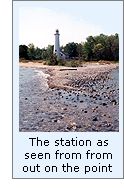 For unspecified reasons, the station's
lens was damaged in 1887, and sent to the lighthouse Depot at Staten
Island for repair over the winter. Apparently damaged beyond repair, a
new lens was sent to Sturgeon Point, and placed into service on the
opening of the 1888 navigation season. While the cribs and breakwater
installed in 1885 were still in good condition, the decision was made to
augment them with two additional cribs to provide further protection.
With the lowest bid for the work submitted at $1,050.70, Eleventh
District Engineer Major Samuel M. Mansfield felt the bid was excessive,
and decided to have the work done under the supervision of one of the
District's construction foremen. After hiring the needed labor and
purchasing materials on the open market, the work was completed in 1888
for a total of $734.59, representing a thirty percent reduction from the
original low bid. For unspecified reasons, the station's
lens was damaged in 1887, and sent to the lighthouse Depot at Staten
Island for repair over the winter. Apparently damaged beyond repair, a
new lens was sent to Sturgeon Point, and placed into service on the
opening of the 1888 navigation season. While the cribs and breakwater
installed in 1885 were still in good condition, the decision was made to
augment them with two additional cribs to provide further protection.
With the lowest bid for the work submitted at $1,050.70, Eleventh
District Engineer Major Samuel M. Mansfield felt the bid was excessive,
and decided to have the work done under the supervision of one of the
District's construction foremen. After hiring the needed labor and
purchasing materials on the open market, the work was completed in 1888
for a total of $734.59, representing a thirty percent reduction from the
original low bid.
In the early days of the US lighthouse
service, lard and sperm oil ware used for fueling the lamps. Relatively
non-volatile, the oil was stored in special rooms in lighthouse cellars
or in the dwelling itself. With a change to the significantly more
volatile kerosene, a number of devastating dwelling fires were
experienced, and beginning late in the 1880's the Lighthouse Board began
building separate oil storage buildings at all US light stations. To
this end, the metalwork for a sheet iron oil storage building was
delivered at the Detroit depot in 1892, and loaded on the lighthouse
tender AMARANTH late that year. A work crew arrived at the station the
following spring, erected the oil storage structure and installed a
below ground cistern by the dwelling. The downspouts from the dwelling
roof were equipped with diverters, allowing runoff from the roof to flow
directly into the cistern or to be diverted onto the ground. On
completion of the installation, the pump at the sink in the dwelling
kitchen was re-plumbed so as to draw its water from the cistern. In
practice, the keepers kept the diverters closed so when rain came they
would allow the rainwater to clean the roof for a period of time before
opening the diverters to allow the water to enter the cistern. While to
our twenty-first century sensibilities, the practice of drinking and
cooking with water that had run from the roof sounds disgusting, it was
a commonplace practice at light stations in the late 1800's.
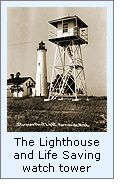 Rapid advancements in the application
of acetylene for lighthouse illumination at the turn of the twentieth
century, coupled with the invention of the sun valve, afforded the
Lighthouse Service the opportunity to experiment with automating a
number of Lights around the Great Lakes. In 1907, the Charity Island
Light was thus automated, and Sturgeon Point followed in 1913. With the
installation of the acetylene equipment, the characteristic of the light
was also changed from fixed white to flashing white every 3 seconds.
Keeper Cardy also passed away in 1913, making him the last full-time
Keeper to be assigned to the station. It is possible that the need to
find a Keeper to replace Cardy may have served as the District's primary
motivating factor in its automation of Sturgeon Point. With automation,
responsibility for maintenance of the light was turned over to the Coast
Guardsmen at the Life Saving station. Rapid advancements in the application
of acetylene for lighthouse illumination at the turn of the twentieth
century, coupled with the invention of the sun valve, afforded the
Lighthouse Service the opportunity to experiment with automating a
number of Lights around the Great Lakes. In 1907, the Charity Island
Light was thus automated, and Sturgeon Point followed in 1913. With the
installation of the acetylene equipment, the characteristic of the light
was also changed from fixed white to flashing white every 3 seconds.
Keeper Cardy also passed away in 1913, making him the last full-time
Keeper to be assigned to the station. It is possible that the need to
find a Keeper to replace Cardy may have served as the District's primary
motivating factor in its automation of Sturgeon Point. With automation,
responsibility for maintenance of the light was turned over to the Coast
Guardsmen at the Life Saving station.
With the Coast Guard's complete assumption of
responsibility for the nation's aids to navigation in 1939, and the
running of electrical power out to Sturgeon Point, the light was
electrified through the installation of an incandescent bulb in the lens
that same year. While Coast Guardsmen continued to tend the light for a few years thereafter, the
station's importance waned, and it appears that the last crew left the
Sturgeon Point station in 1941.
No longer inhabited, the wooden
structures of the Life Saving station deteriorated rapidly, and
constituting an attractive nuisance, were subsequently destroyed. The
lighthouse dwelling and tower were vandalized, however their sturdy
brick construction limited the damages to windows, doors and interior
walls and woodwork. The Alcona Historical Society obtained a lease to
the lighthouse structures in 1982, and began an intensive three-year
volunteer restoration project. The dwelling now serves as a maritime
museum, and is open to the public seven days a week from Memorial Day to
mid September. The grounds are open to the public all year.

Keepers of
this Light

Click here
to see a complete listing of all Sturgeon Point Light keepers compiled
by Phyllis L. Tag of Great Lakes Lighthouse Research.

Seeing this Light

Sturgeon Point lighthouse is one of the most picturesque to be found in
the area. The stark contrast of the bright white painted bricks with the
deep red trim makes the building very photogenic. Sitting on the shore
end of a long and shallow submerged finger of land that juts into Lake
Huron, it is plain to see why a lighthouse was needed here in the days
before radar and Loran.
Leaving most of the camera gear hidden in some
scrub bushes, we gingerly made our way out into the water to capture the
image seen in the upper right, the rocks making the way uncomfortable to
our bare feet. We then toured the building, which has been completely
restored in a very tasteful manner, giving the appearance that the
keeper had just left some of the rooms ahead of us. Unfortunately, the
tower was not open to the public, as it is still used as an active aid
to navigation. Interestingly, we could see no remaining signs of the
shore protection cribs and piers that were installed in the 1880's.
Returning to our truck, I realized that my glasses were
missing, and retracing our steps through the grounds, we found them
lying beneath the bush where we had left the photo equipment earlier.

Finding this
Light
Take US 23 North approximately three miles out of Harrisville, turn
right onto Lakeshore Drive and continue approximately one mile to Point
Road. Turn East on to Point Road, and continue approximately one mile to
the gravel road on the left that enters the lighthouse parking area. It
is a short walk further down this road to this charming lighthouse.

Contact
information

Sturgeon Point Lighthouse & Maritime Museum
Sturgeon Point Road
Harrisville, MI 48740
(517) 724-5107

 Reference
Sources Reference
Sources

Annual reports of the Lighthouse Board, various, 1867 - 1909
Annual reports of the Lighthouse Service, 1910 - 1929
Annual reports of the Lake Carrier's Association, 1908 - 1930
Telephone call to Don Sawyer, VP Alcona Historical Society,
6/1/2000
USCG Historian's Office -
photographic archives.
The Northern Lights, Charles K Hyde, 1986
Personal observation at Sturgeon Point, 09/11/1998
Photographs from the author's personal collection.
Keeper listings for this light appear courtesy of Tom & Phyllis Tag
|
